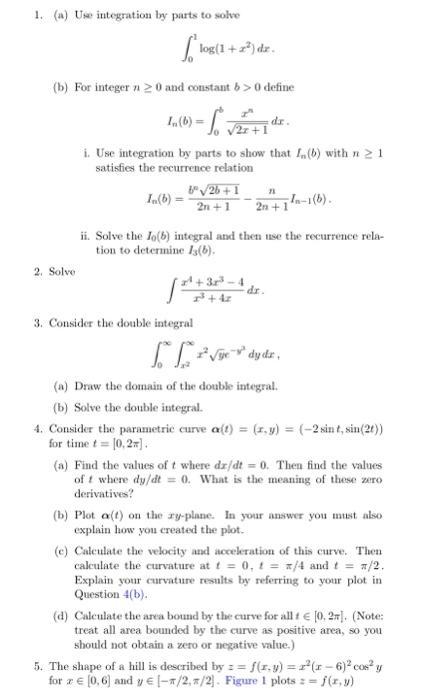Answered step by step
Verified Expert Solution
Question
1 Approved Answer
1. (a) Use integration by parts to solve (b) For integer n 20 and constant b>0 define In (b) = So 2+1 d 2

![z=f(x,y) 100 50 ON */4 Figure 1: The hill of Question 5 modelled by = f(z. y) = x(x - 6) cos y for 2 [0,6]](https://dsd5zvtm8ll6.cloudfront.net/si.experts.images/questions/2023/09/64fbfe3a16959_1694236198372.jpg)
1. (a) Use integration by parts to solve (b) For integer n 20 and constant b>0 define In (b) = So 2+1 d 2 2. Solve log(1 +2) dr. i. Use integration by parts to show that I, (b) with n 2 1 satisfies the recurrence relation In(b) ii. Solve the Io(b) integral and then use the recurrence rela- tion to determine 13(b). B2b + 1 2n + 1 +3-4 2+ 4z 3. Consider the double integral dr. 11 2n+1 dr. -In-1(b). [[* gedy dr, (a) Draw the domain of the double integral. (b) Solve the double integral. 4. Consider the parametric curve a(t) = (r.y)= (-2 sint, sin(2t)) for time t = [0,2]. (a) Find the values of t where dr/dt = 0. Then find the values of t where dy/dt = 0. What is the meaning of these zero derivatives? (b) Plot a(t) on the ry-plane. In your answer you must also explain how you created the plot. (e) Calculate the velocity and acceleration of this curve. Then calculate the curvature at f = 0, 1 = x/4 and t = x/2. Explain your curvature results by referring to your plot in Question 4(b). (d) Calculate the area bound by the curve for all 1 [0.2m]. (Note: treat all area bounded by the curve as positive area, so you should not obtain a zero or negative value.) 5. The shape of a hill is described by = f(r.y)=(1-6) cos y for x = [0,6] and y = -x/2.7/2]. Figure 1 plots == f(x,y) z=f(x,y) 100 50 ON */4 Figure 1: The hill of Question 5 modelled by = f(z. y) = x(x - 6) cos y for 2 [0,6] and y [-/2,=/2). (a) Where on the hill is the steepest slope in the direction? (b) Where on the hill is the steepest slope in the y direction? How steep is this slope? (e) Use partial derivatives to find the location of the maximum and minimum heights of the hill. (The maximum and mini- mum should be clear from Figure 1, but confirm them with partial derivatives.) 6. Consider f(x) = e cos z over the domainz [-*.*] (a) Construct the Taylor polynomial of order three pa(r) about To=0. (b) Write a formula for the Lagrange Remainder term Rs(r) for Taylor polynomial pa(z) about zo=0. Your solution should be simplified as much as possible, and it should be in terms of an unknown constant c. Make sure you define the domain of c. (e) For the domain [0, ], what is the upper bound of the absolute value of the Lagrange remainder term [R(e) at any r? In other words, what is the worst-case scenario for the Lagrange remainder term? (d) Calculate function f(x), Taylor polynomial ps(r), error f(x)- ps(r) and the upper bound of Ra(z)) at r=0.0.5, 1.0, . For all four values of r, is the error of the Taylor polynomial within the expected range? Comment on how the error changes as 2-ro increases.
Step by Step Solution
★★★★★
3.36 Rating (159 Votes )
There are 3 Steps involved in it
Step: 1
Sure Ill go through each of the questions one by one and provide the solutions 1 a To solve the integral 0 to 1 log1 x2 dx using integration by parts we can choose u log1 x2 and dv dx Then du 2x 1 x2 ...
Get Instant Access to Expert-Tailored Solutions
See step-by-step solutions with expert insights and AI powered tools for academic success
Step: 2

Step: 3

Ace Your Homework with AI
Get the answers you need in no time with our AI-driven, step-by-step assistance
Get Started


